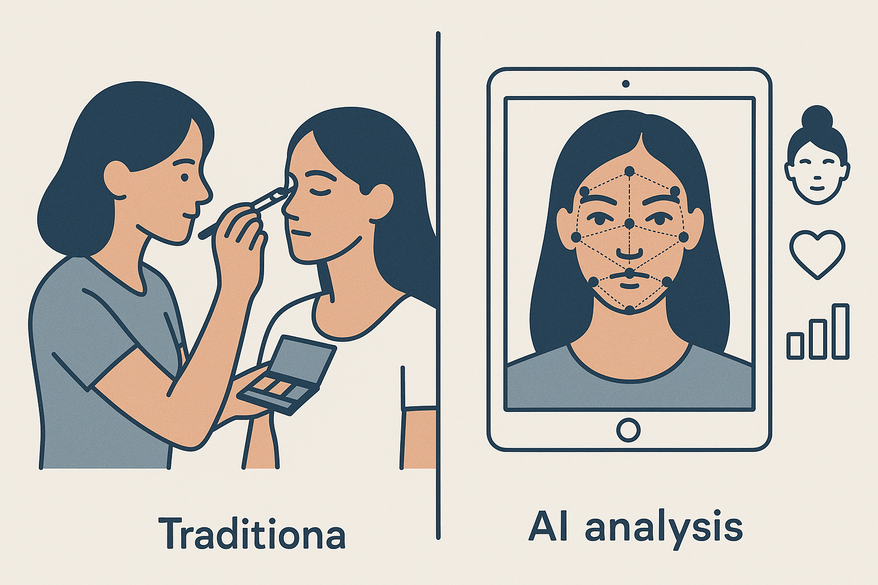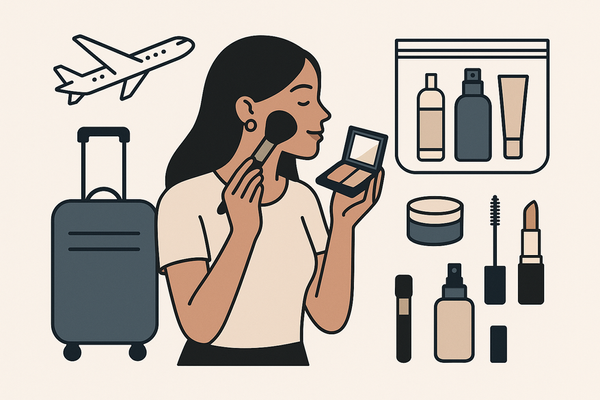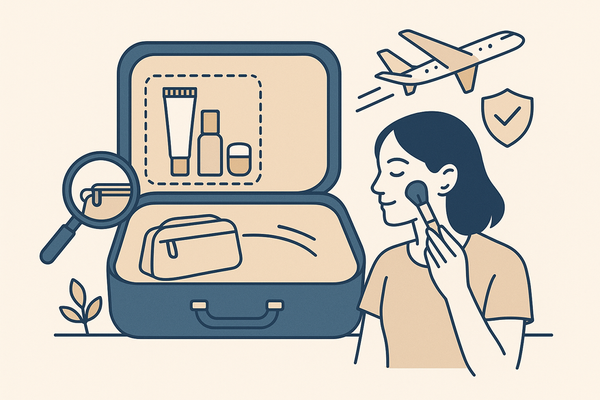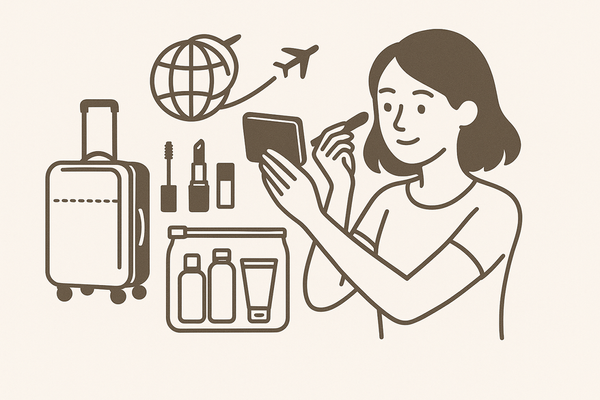Traditional Makeup vs AI Analysis: A Complete Guide
Explore how traditional makeup artistry compares to AI analysis in beauty. Discover their strengths, limitations, and impact on consumers and the beauty industry.

Estimated reading time: 8 minutes
Key Takeaways
- Hands-On Artistry vs Digital Precision: Traditional makeup leverages artistic skill and personal touch, while AI analysis offers consistent, data-driven recommendations.
- Personalization: Artists adjust in real time based on lighting and client feedback; AI delivers instant matches by analyzing pixels and color profiles.
- Accessibility: Salon visits and appointments make traditional makeup less scalable; AI apps provide 24/7 global access.
- Strengths & Limitations: Human intuition excels in creativity and emotional connection; AI excels in speed, repeatability, and scalability but can suffer bias and lacks artistic flair.
- Hybrid Models: Combining AI color profiling with in-studio artistry often yields the best of both worlds.
Table of Contents
- Traditional Makeup Overview
- Introduction to AI Analysis
- Comparing Traditional Makeup vs AI Analysis
- Benefits and Limitations of AI Analysis
- Ethical Considerations
- Impact on the Beauty Industry
- Conclusion
- FAQ
Traditional Makeup Overview
In traditional makeup, artists use tools and techniques passed down through salon and art academy training. They blend creativity, color theory, and manual skills to transform a face in real time.
Key Techniques and Tools
- Brushes and sponges for foundation, blending, and contouring
- Eyeshadow palettes and contour kits for highlights and shadows
- Color matching by eye using swatches on the jawline or wrist
- Guiding principles like the golden ratio for facial harmony
Role of Makeup Artists
- Assess face shape, skin tone, and symmetry in person
- Adjust looks on the fly based on lighting and client feedback
- Use intuition and experience for nuanced corrections
Historical and Cultural Context
- Origins in early 1900s salons and European art academies
- Regional traditions (e.g., Kabuki makeup in Japan, ancient Egyptian kohl)
- Builds trust through face-to-face interaction and a personal touch
Real-World Example
As a professional artist, I’ve seen clients relax when we chat about daily routines while I apply foundation. That bond can’t be fully replicated by a screen.
Introduction to AI Analysis
AI analysis brings data science to beauty. It relies on algorithms to scan, measure, and recommend without a brush in hand.
For instance, Makeup Check AI harnesses machine learning and computer vision to analyze skin undertones and generate tailored makeup recommendations in seconds. Its precision-driven approach showcases the potential of data-powered beauty solutions.
What Is AI Analysis?
- Machine learning algorithms process digital photos of your face
- Computer vision breaks images into pixels, identifying color, brightness, and texture
- Data algorithms detect undertones, skin type, and facial grids
Technology Behind AI Makeup Tools
- High-resolution facial scanning with smartphone cameras or kiosks
- Neural networks trained on thousands of diverse skin tones
- Real-time face mapping, colorimetry, and seasonal analysis algorithms
Learn more about cutting-edge beauty apps in our AI Makeup Coach guide.
Common Applications
- Automated foundation and concealer matches
- Lip and eye palette suggestions based on undertone data
- Virtual try-ons that overlay digital makeup on a live image
- Apps that learn from user feedback to refine recommendations
Discover how virtual try-ons are redefining shopping.
Industry Example
Wear Palette’s AI engine can scan a selfie and match you to a seasonal color palette in under 60 seconds. That speed democratizes expert advice—no salon visit needed.
Comparing Traditional Makeup vs AI Analysis
This side-by-side look shows how human artistry and data-driven precision stack up.
Feature Comparison
- Process
• Traditional: Manual, creative, hands-on
• AI: Digital, automated, algorithmic - Reliability
• Traditional: Varies by artist skill and tools
• AI: Consistent repeatability from code - Personalization
• Traditional: Intuitive, bespoke adjustments
• AI: Data-driven matches based on pixels - Creativity
• Traditional: High flexibility, new looks on demand
• AI: Limited to patterns in its training data - Accessibility
• Traditional: Requires appointments and travel
• AI: 24/7 app access worldwide
Strengths & Weaknesses
- Traditional makeup
• Emotional connection with client
• Infinite creative expression
• Cultural artistry preserved - AI analysis
• Instant results, no waiting room
• Objective and repeatable color matches
• Scalable to millions of users - Weaknesses—Traditional
• Time-intensive sessions
• Dependent on artist availability and skill level - Weaknesses—AI
• Possible algorithmic bias against underrepresented skin tones
• Lacks emotional intuition and artistic flair
• Relies on photo quality and lighting
Hybrid Approaches
Many brands now combine AI color profiling with in-studio artistry. An app suggests your perfect base shade, and an artist adds creative finishing touches—inspired by insights from our foundation shade match guide.
Benefits and Limitations of AI Analysis
Benefits of AI Analysis
- Efficiency
• Instant skin tone and undertone detection
• Fast product recommendations in minutes - Data-Driven Personalization
• Objective color matching based on large datasets
• Repeatable accuracy across sessions - Accessibility
• Remote consultations via smartphone or desktop
• Equalizes reach for rural or busy consumers
Limitations of AI Analysis
- Algorithmic Bias
• Potential to misread or oversimplify darker or unusual skin tones
• Requires diverse training data to improve fairness - Creativity Gap
• Cannot improvise bold or experimental looks outside its dataset - Privacy Concerns
• Needs clear consent for facial image use and storage
• Data security must be transparent to build trust
Contrast: Traditional Makeup Benefits & Limitations
- Benefits
• Artistry & Creativity: Endless design choices
• Personal Touch: Face-to-face trust building
• Cultural Heritage: Keeps old techniques alive - Limitations
• Results vary by artist and environment
• Hard to scale services globally
• Scheduling and travel can be a barrier
Ethical Considerations
Data Privacy and Consent
- Users must know how facial scans are stored and used
- Transparent policies build trust and lower data-leak risk
Algorithmic Fairness
- Models should be trained on a wide range of skin tones
- Regular audits are needed to uncover hidden biases
Beauty Standards and Diversity
- Avoid reinforcing narrow ideals (e.g., only lighter skin matches)
- Celebrate all skin colors, ages, and face shapes in training sets
Trust-Building Practices
- Open-source some algorithm details
- Allow users to opt out and delete their data at any time
Impact on the Beauty Industry
Trends and Consumer Behavior
- Surge in digital-first consultations via apps and kiosks
- Growth in personalized product lines guided by data
- Rising consumer demand for hybrid services (digital + in-person)
Future Prospects
- Augmented reality (AR) try-ons in storefront mirrors
- AI-powered diagnostic kiosks in retail stores
- Collaboration platforms where artists receive AI insights
Industry Example
A major beauty retailer now uses AI skin scanners in store. Shoppers scan their face, get product codes, then meet an in-store artist to finalize the look.
Conclusion: Traditional Makeup vs AI Analysis
Traditional makeup offers emotional connection, creative freedom, and hands-on artistry. AI analysis brings efficiency, objective precision, and global accessibility. Hybrid models often deliver the best of both worlds—data-driven palette selection followed by expert finishing touches.
Your choice depends on your priorities: deep personal touch or instant digital accuracy. Consider your lifestyle, budget, and need for creativity when choosing between these approaches.
Call-to-Action: Share Your Thoughts
Tell us about your first AI color match or your favorite in-studio makeup session. Comment below on whether you trust the artist’s brush or the algorithm’s code. Follow our blog for more on the future of beauty and technology.
FAQ
- What is the main difference between traditional makeup and AI analysis? Traditional makeup relies on manual application and artistic intuition, while AI analysis uses algorithms and data to provide consistent, repeatable recommendations.
- Can AI replace experienced makeup artists? AI excels at speed and objectivity but lacks the creative flair and emotional connection of a skilled artist. Hybrid approaches are on the rise.
- How accurate are AI color matches? Accuracy depends on photo quality and algorithm training. Leading tools offer high precision but may still misread underrepresented skin tones.
- Is my facial data safe with AI beauty apps? Always review privacy policies. Reputable platforms offer clear consent processes and allow users to delete their data.
- Which approach should I choose? It depends on your needs: go traditional for a bespoke, artistic experience; choose AI for quick, data-driven matches; or combine both for optimal results.




